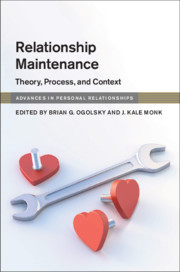Book contents
- Relationship Maintenance
- Advances in Personal Relationships
- Relationship Maintenance
- Copyright page
- Contents
- Tables
- Figures
- Contributors
- Part I Introduction
- Part II Theories of Relationship Maintenance
- 2 Interdependence Perspectives on Relationship Maintenance
- 3 An Evolutionary, Life History Theory Perspective on Relationship Maintenance
- 4 Relationship Maintenance from an Attachment Perspective
- 5 Uncertainty Perspectives on Relationship Maintenance
- 6 The Self-Expansion Model and Relationship Maintenance
- Part III Processes of Relationship Maintenance
- Part IV The Social Context of Relationship Maintenance
- Part V Conclusion
- Index
- References
3 - An Evolutionary, Life History Theory Perspective on Relationship Maintenance
from Part II - Theories of Relationship Maintenance
Published online by Cambridge University Press: 02 December 2019
- Relationship Maintenance
- Advances in Personal Relationships
- Relationship Maintenance
- Copyright page
- Contents
- Tables
- Figures
- Contributors
- Part I Introduction
- Part II Theories of Relationship Maintenance
- 2 Interdependence Perspectives on Relationship Maintenance
- 3 An Evolutionary, Life History Theory Perspective on Relationship Maintenance
- 4 Relationship Maintenance from an Attachment Perspective
- 5 Uncertainty Perspectives on Relationship Maintenance
- 6 The Self-Expansion Model and Relationship Maintenance
- Part III Processes of Relationship Maintenance
- Part IV The Social Context of Relationship Maintenance
- Part V Conclusion
- Index
- References
Summary
Relationship maintenance is a central topic in relationship science. Most relationship scholars examine relationship maintenance at the proximate level of causation by examining how variables such as immediate threats to a relationship or an individual’s degree of commitment elicit the motivation to maintain it. Far less attention has been granted to distal factors, such as each partner’s developmental history or the possible evolutionary origins of relationship maintenance tendencies. The primary goal of this chapter is to shed clarifying light on these understudied levels of analysis by viewing relationship maintenance processes from an evolutionary-developmental perspective. We first review two central evolutionary frameworks (the Strategic Pluralism Model and Life History Theory) and integrate them within a single model called Developmental Strategic Pluralism. Drawing from this novel framework, we derive a set of testable predictions regarding relationship maintenance processes with the ultimate goals of contextualizing proximate relationship processes within evolutionary thinking and stimulating new avenues for future research in this rapidly growing area of relationship science.
- Type
- Chapter
- Information
- Relationship MaintenanceTheory, Process, and Context, pp. 29 - 46Publisher: Cambridge University PressPrint publication year: 2019
References
- 1
- Cited by



